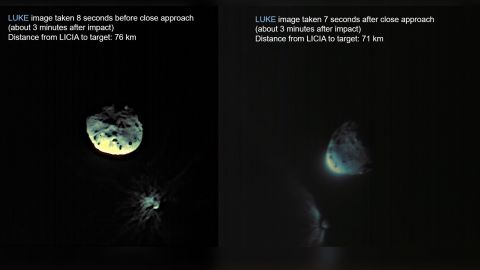Sign up for CNN’s Wonder Theory science newsletter. Explore the universe with news on fascinating discoveries, scientific advancements and more.
CNN
—
When NASA’s Double Asteroid Redirection Test spacecraft slammed into the tiny asteroid Dimorphos, the impact certainly left a mark.
The intentional collision, which took place on September 26 as a test of asteroid deflection technology, displaced more than 2 million pounds (1 million kilograms) of rocks and dust from the asteroid into space. Scientists estimate it was enough material to fill about six or seven rail cars.
The insights gained from the collision are helping scientists learn how this planetary defense technique might be used in the future. That’s if an asteroid is ever discovered to be on a collision course with Earth.
Neither Dimorphos, nor the larger asteroid Didymos that it orbits, pose a threat to Earth, but the system made for excellent target practice.
New findings and images from the impact were shared Thursday at the American Geophysical Union Fall Meeting in Chicago.
“What we can learn from the DART mission is all part of a NASA’s overarching work to understand asteroids and other small bodies in our Solar System,” said Tom Statler, program scientist for DART at NASA, in a statement.
“Impacting the asteroid was just the start. Now we use the observations to study what these bodies are made of and how they were formed — as well as how to defend our planet should there ever be an asteroid headed our way.”
Images captured by space and ground-based telescopes before and after the impact are helping scientists piece together what happened when the spacecraft crashed into Dimorphos at about 14,000 miles per hour (22,530 kilometers per hour).
The DART team calculated that the transfer of momentum when the spacecraft hit the asteroid was 3.6 times greater than if the asteroid had absorbed the spacecraft and no material was blasted from the surface. The momentum created when Dimorphos’ surface material blasted out into space contributed to moving the asteroid more than the spacecraft did, the researchers said.
“Momentum transfer is one of the most important things we can measure, because it is information we would need to develop an impactor mission to divert a threating asteroid,” said Andy Cheng, DART investigation team lead from the Johns Hopkins Applied Physics Laboratory in Laurel, Maryland, in a statement.
“Understanding how a spacecraft impact will change an asteroid’s momentum is key to designing a mitigation strategy for a planetary defense scenario.”

The DART mission successfully changed the trajectory of the asteroid Dimorphos, marking the first time humanity intentionally changed the motion of a celestial object in space.
Prior to impact, it took Dimorphos 11 hours and 55 minutes to orbit Didymos. Now, it takes Dimorphos 11 hours and 23 minutes to circle Didymos. The DART spacecraft changed the moonlet asteroid’s orbit by 32 minutes.
Initially, astronomers expected DART to be a success if it shortened the trajectory by 10 minutes.